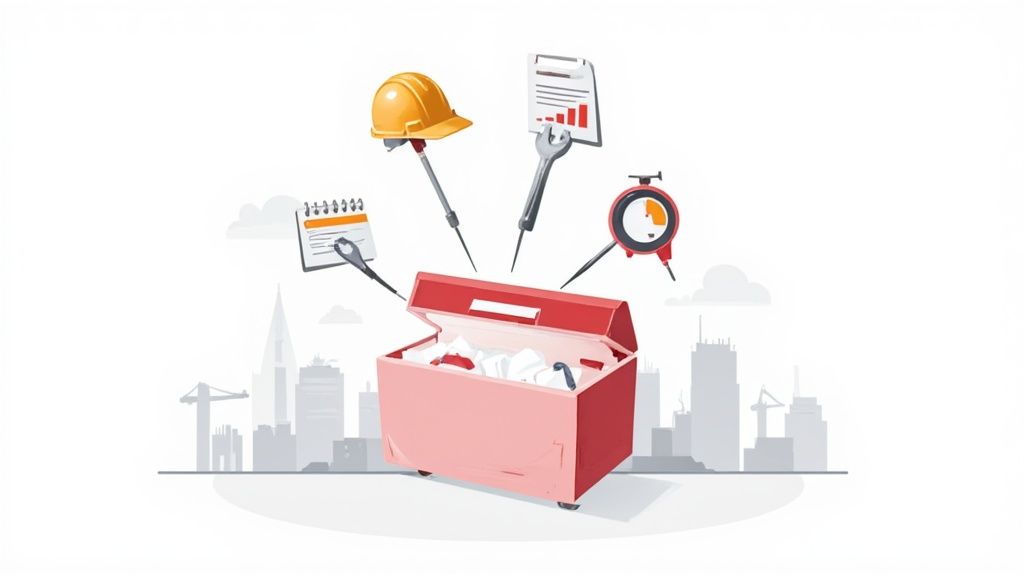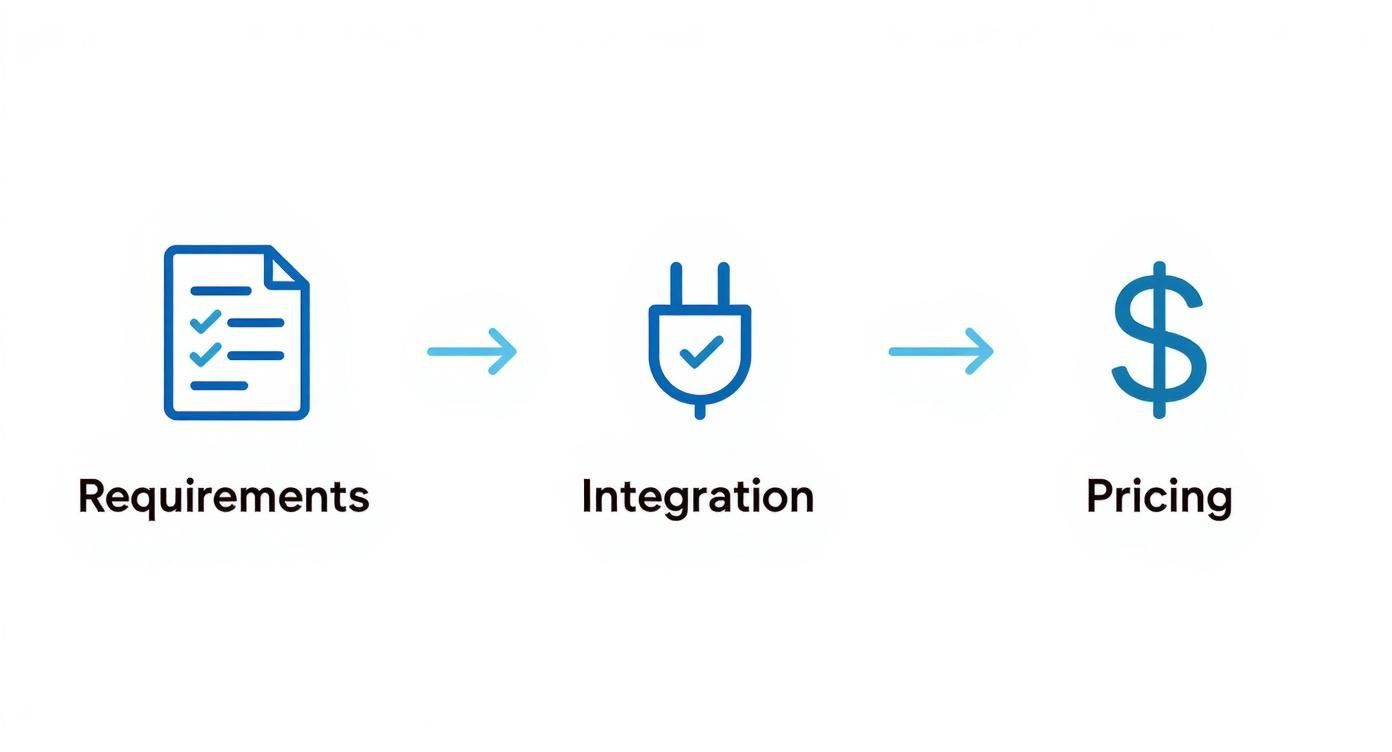Risk control software gives you a digital toolbox for site safety. It replaces spreadsheets and paper forms with one platform for hazard registers, incident logs, contractor pre-qualifications, audit schedules and dashboards. You cut admin time, reduce errors and get real-time data at managers hands.
Construction and manufacturing teams can’t afford gaps. A single outdated Excel sheet can trigger compliance fires. Risk control software keeps records current and accessible on demand.
Understanding Risk Control Software
When a team adopts risk control software, they end up with one source of truth for every safety record. No more shuffling paper or juggling multiple Excel files across sites. Everything’s logged, tagged and ready for a regulator inspection or surprise audit in seconds.
Each module matches a specific task. A hazard-tracking template sits next to mobile incident reporting, contractor checks live alongside audit management and analytics brings it all together. This setup cuts data silos so your crew spends less time on form-filling and more time on practical safety measures.

Key Modules And Use Cases:
- Risk Assessment: Automatically rank hazards and assign controls with ready-made templates
- Incident Reporting: Capture near-misses and injuries on the go, directly from mobile devices
- Contractor Management: Check licences and insurance before subcontractors arrive
- Audit Scheduling: Set dates, remind stakeholders and track follow-ups to completion
- Analytics Dashboard: Find trends and hotspots so you deal with issues before they escalate
"Switching from spreadsheets to a unified platform reduces error by centralising updates in one place," says one safety manager.
You’ll see this market expand fast. Australia’s risk management software sector hit USD 270 million in 2024 and, at a 12.55% CAGR, is forecast to reach USD 782.48 million by 2033 as digital tools become core to compliance. Dive deeper into Australia’s risk management market.
How Modules Share Data
Modules don’t work in isolation. An incident logged on site can trigger a follow-up assessment, schedule an audit and update your dashboard.
Australia Risk Management Market Growth
Below is a snapshot of projected growth in Australia’s risk management software market.
| Year | Market Value (USD million) |
|---|---|
| 2024 | 270 |
| 2027 | 410 |
| 2030 | 620 |
| 2033 | 782.48 |
This forecast shows steady expansion and highlights the growing need for digital risk controls.
In this guide, you’ll find:
- A selection checklist to match software features with your workflows
- A step-by-step rollout roadmap
- Methods to calculate ROI and track compliance gains
Learn more about ISO 31000 risk management in our article
By the end, you’ll be ready to pick, install and prove the impact of a platform like Safety Space from day one, keeping your sites safe and compliant.
Key Modules In Risk Control Software
Think of your risk control software as a central operations room. Each module acts like a console, monitoring a critical aspect of safety on site. Together, they form a tight-knit system that spots issues before they become problems.

Risk Assessment Station
This is where hazards get a score and a priority. A live scaffold inspection, for example, might jump straight to your top-three alerts.
Key Features:
- Automated Scoring Using built-in rules
- Custom Templates For different work zones
- Integration With your control measures workflow
Tags link hazards to control tasks automatically, so your crew knows what to tackle first.
Incident Reporting Station
Field teams tap a few buttons on their phones and reports land in your dashboard instantly.
Highlights:
- Reporting in under 2 minutes
- Image uploads add real-world context
- Instant alerts keep everyone in the loop
Timestamp and GPS data boost investigation accuracy, turning a near-miss into a teaching moment.
Contractor Management Station
All your subcontractor paperwork lives in one place—licenses, insurances, certifications.
Benefits:
- Expiry reminders prevent lapsed credentials
- A locked dashboard stops unqualified workers at the gate
- Auto-generated compliance reports for stakeholders
"Centralising our contractor checks cut site delays by 30%," says one regional manager.
Audit Scheduling Station
Plan audits, attach checklists and get automatic reminders when deadlines approach.
Why It Matters:
- Assign audits to teams and track status in real time
- Findings feed directly into corrective action plans
- Fewer missed checks, less paperwork
Keeping audits on schedule means closing safety gaps faster.
Analytics Dashboard Station
Here, all your data streams converge into clear visuals.
What You’ll See:
- Heatmaps showing incident hotspots
- Trend lines to track performance over time
- Custom widgets you can filter by date, location or incident type
With these insights, you can tackle root causes, not just symptoms.
Core Module Comparison
| Module | Primary Function | Key Benefit |
|---|---|---|
| Risk Assessment | Rank hazards and suggest controls | Focus your team on the most pressing risks |
| Incident Reporting | Capture events in real time | Faster follow-up and resolution |
| Contractor Management | Manage credentials and renewals | Keep only qualified crews on site |
| Audit Scheduling | Plan audits and track results | Reduce missed checks and admin load |
| Analytics Dashboard | Analyse trends and report performance | Spot patterns and drive continuous improvement |
Each module plays a distinct role, and they all feed into the same goal: a safer, more proactive site.
Dive deeper into tactics by exploring our guide on control measures for risks.
Industry Benefits In Construction And Manufacturing
Construction and manufacturing teams juggle tight schedules, scattered sites and heaps of paperwork. Risk control software brings visibility to where it matters—on the tools and the shop floor.
Construction Benefits
Mobile incident reporting flags issues immediately, stopping bigger headaches later. Digital permit-to-work checks on tablets ensure no one starts a job without the green light.
- Mobile Incident Reporting logs issues with GPS tags and photos, cutting downtime by up to 50%
- Digital Permit Checks automate approval steps, reducing manual errors by 60%
- Near-Miss Capture raises alarms early so teams can fix gaps before they grow
"Using mobile incident reports cut our site downtime by 25% overnight," recalls one site manager.
Manufacturing Benefits
In a factory, contractor management is your quality gatekeeper. Suppliers only pass through once licenses and compliance paperwork are in order. Regular audits keep machines running and inspections on schedule.
- Contractor Management spots expired licenses and stops unqualified suppliers at the gate
- Audit Workflows schedule, track and close checks, boosting audit readiness by 40%
These modules mean fewer surprises on the line and safer shifts for everyone.
For a guide to fleet safety management, which cuts operational risks and ensures compliance for vehicles and personnel, see: comprehensive guide to fleet safety management.
Market And Performance Metrics
The global risk management software market is set to hit USD 13.05 billion in 2025 and USD 28.31 billion by 2030 at a 16.75% CAGR. Cloud solutions lead growth with a 21.3% CAGR. Read the full research on global risk management software market growth.
Teams see 30% fewer incidents after rolling out mobile reporting and quality gates. Insurers often cut premiums by 24% once they see complete electronic audit trails. And audit readiness improves by 40%, shrinking cycles from days to hours.
| Metric | Before Software | After Software |
|---|---|---|
| Incident Count | Baseline | – 30% |
| Insurance Premiums | Baseline | – 24% |
| Audit Readiness Cycle | Days | Hours |
Bringing field reports, permits, contractor records and audits together turns safety checks into everyday quality gates—protecting people and profits in equal measure.
Practical Example
A WA builder caught a loose roof sheet within minutes using a mobile log. That afternoon they completed the permit check on the same device and cleared scaffolding works ahead of schedule. Contractor checks then barred an unlicensed subbie before they even set foot on site.
The live audit dashboard showed machine inspections, letting project managers close 85 out of 100 actions in just two days.
- Worker logs hazard with a photo on mobile
- Supervisor approves permit digitally in minutes
- System alerts team to expired licenses
- Audit crew reviews live compliance dashboard
Across three sites, this process delivered a 35% drop in recordable incidents and reclaimed 200 admin hours every month.
Choosing risk control software with these core modules makes measurable safety improvements part of your daily routine. Managers should map current workflows, benchmark performance and compare results before and after. A simple checklist covering mobile reporting, permit checks, contractor controls and audit scheduling will help match the right solution to your projects.
Software Evaluation And Procurement Checklist
Picking a risk control platform isn’t just about sticker price. You need a roadmap to avoid mismatches and extra costs down the track.
First, outline your workflows to zero in on real pain points and cut out irrelevant features.
Next, check vendor stability and track record. You want a partner who will still be around, pushing updates and refining features for years.
Test integrations early—mock connections with your HR system and reporting tools so you dodge surprises at go-live.
Review support and training. Even the best software only works when you know how to use it and have help when you need it.
Compare pricing models. Subscriptions, per-user licenses and add-ons can push your costs up.
- Define Requirements: List current and future workflows, modules and outputs you need
- Vendor Stability: Check financial health, customer base and release cadence
- Integration Points: Confirm APIs, import/export formats and connectors
- Support Services: Review training programs, documentation and service levels
- Pricing Models: Ask about setup fees, license tiers and any hidden charges
Define Business Requirements
Set clear, measurable goals for your team. For example, cut incident reporting time by 50% or free up 200 admin hours monthly. These targets will guide vendor demos and trials.
Key questions:
- Which modules support mobile workflows?
- How flexible are your hazard templates?
- Can we restrict user roles by project?
Vague answers or missing case studies are warning signs. Insist on a demo using your data to check critical features.
Assess Vendor Stability
Look at how long each vendor has been trading and their customer retention rates. A high churn rate often signals product or support issues.
Check third-party reviews and testimonials. 73% of users report faster implementations when on-site training is included.
"Choosing a vendor with a proven track record saved us months of rework," says one operations manager.
Also inspect update schedules. Regular releases mean active development, but watch for disruptive upgrade cycles.
| Pricing Model | Setup Fee | Licence Type | Pros | Cons |
|---|---|---|---|---|
| Subscription | Low | Monthly or yearly | Predictable ongoing spend | Continuous expense |
| Per-User License | Medium | Seat-based | Scales with your team | Can get expensive at scale |
| Perpetual License | High | One-off purchase | Fixed ownership cost | Major fees for future updates |
Review integration test results and SLA terms. Make sure trials run long enough for your full rollout.
See our guide on integrated H&S management in our article on Health and Safety management software to see how smooth deployment can look.
Confirm Your Choice
A structured evaluation keeps marketing claims in check and focuses on solutions that meet your needs. Rank each vendor and module on a scorecard to simplify stakeholder discussions.
Trials with live workflows reveal hidden snags early and build user confidence. This data-driven approach makes procurement a team win, earning buy-in from every corner.
Implementation Roadmap And Change Management
Rolling out risk control software is like building a house: each stage must be solid before you add the next layer.
Start with data migration—your foundation—and finish with custom dashboards, the trim and paint.
A phased approach keeps teams aligned. First, align stakeholders. Then run a pilot, deliver training and gather feedback.
Key Roadmap Phases
- Align Stakeholders: Set goals and assign roles
- Plan And Execute A Pilot: Use real workflows to validate the setup
- Help End Users With Hands-On Sessions: Train users on key tasks
- Create Feedback Loops: Gather insights for ongoing tweaks

This flow shows how clear requirements lead to smooth integration and predictable pricing decisions.
Phase 1 Align Stakeholders
Map every user group—from executives to on-site teams. Define success criteria like faster reporting or fewer manual errors.
- List user groups: executives, managers, on-site teams
- Agree on success criteria and deadlines
- Keep scope tight to prevent delays
Phase 2 Pilot Planning
A pilot lets you test software in a controlled setting. Choose a representative site or team and track metrics like report completion time and user adoption rates.
"Pilots expose setup gaps early and build champions," says one project lead.
Pilot Tips:
- Pick a small, diverse team
- Use live data to mimic real tasks
- Hold check-ins for quick fixes
Phase 3 Training Workshops
Hands-on workshops help users adapt to new processes. Cover data entry, dashboard use and report generation. Keep sessions under two hours for focus.
Workshop Best Practices:
- Limit groups to 10 participants
- Use real examples from past incidents
- Assign practice tasks and give feedback
Phase 4 Feedback And Iteration
Once the platform is live, open channels for feedback. Weekly surveys and suggestion boards capture pain points and ideas. Feed that back into configuration updates and refresher sessions.
Iteration Checklist:
- Review feedback within 48 hours
- Prioritise fixes that cut manual steps
- Schedule follow-up training for common questions
Embedding New Processes
Lock software tasks into shift handovers and toolbox talks. Celebrate wins like a 30% faster report turnaround to keep teams motivated.
| Channel | Format | Frequency |
|---|---|---|
| Weekly Survey | Online Form | Every Monday |
| Suggestion Board | Paper or Online | Continuous |
| User Group Meet | Virtual Session | Bi-Weekly |
Assign owners and due dates to suggestions—this simple step builds momentum from day one.
Quick Example
A WA construction firm hit 85% adoption in two weeks. Survey feedback revealed a missing incident field. Adjusting the form cut two clicks from the report process.
- Moved 5 years of records in under 24 hours
- Pilot revealed a missing field in the incident form
- Training boosted user confidence and speed
- Feedback trimmed manual review time by 40%
With clear steps, this rollout delivered solid results.
Top Takeaways
- Early alignment saves time
- Pilots expose issues before full rollout
- Feedback loops drive improvements
- Dashboards surface insights fast
Measuring ROI and Compliance Outcomes
Tracking ROI helps link your risk control software investment to real results. Turning goals into clear targets, key performance indicators guide your strategy.
Start with baseline data: monthly lost-time incident counts, manual reporting hours, audit pass rates and average response time.
- Lost-time incident reduction tracks the drop in incidents that cost work hours
- Audit pass rate improvement measures audits that now pass successfully
- Incident response time shows how fast teams close out events
- Manual reporting savings calculates hours saved by ditching paper forms
Set targets like a 30% drop in lost-time incidents or a 50% cut in report prep hours. Clear goals give everyone focus.
Defining Baseline Data
Gather at least three months of historical safety metrics before software goes live. Collect site and department figures for a solid comparison.
Recommended metrics:
- Lost-time injury incidents per site per month
- Average audit pass rate across all sites
- Mean incident response time in hours
- Total hours spent on manual safety reporting
Calculating Dollar-Value ROI
Putting savings in dollar terms helps finance see the impact. If one lost-time incident costs $50,000, cutting ten incidents by 30% saves $150,000 a year.
| Metric | Baseline | Target | Cost per Unit | Annual Savings |
|---|---|---|---|---|
| Lost-time incidents | 10 | 7 | $50,000 | $150,000 |
| Manual reporting hours | 1,200 | 600 | $30 per hour | $18,000 |
| Incident response hours | 300 | 150 | $40 per hour | $6,000 |
Total annual benefit is $174,000. Subtract subscription fees and training to get net ROI.
Tracking Compliance Wins
Good software also keeps you onside with rules like construction site signage requirements.
Track audit efficiency:
- Audit cycle time in days
- Documentation errors in external reviews
- Annual savings from avoided fines
A 40% reduction in audit cycle time across five sites saves 25 audit days. At $1,000 per day, that’s $25,000 saved.
Presenting Results To Stakeholders
Visual reports make your case clear. Dashboards with trend lines and heat maps show what’s improving and what needs work.
Report best practices:
- Before-and-after charts for each KPI
- Dollar savings alongside percentage gains
- Monthly summaries via email or team briefings
- Celebrate wins to keep teams engaged
Continuous Monitoring And Adjustment
Measuring ROI isn’t a one-off task. Review metrics monthly and tweak targets as your processes improve.
Action steps:
- Schedule monthly KPI reviews
- Update dashboards with real-time data from Safety Space
- Adjust goals based on season or project phases
- Document lessons learned for sharper calculations
How To Keep Momentum
Embed ROI and compliance checks into daily routines. Use data in toolbox talks or morning huddles and ask crews to flag anomalies.
Tips:
- Assign each KPI to a team member
- Set alerts for metrics below thresholds
- Link improvements to recognition
- Run quarterly deep dives to find new gains
Case Study Example
A WA-based construction firm rolled out Safety Space and saw a 35% drop in lost-time incidents within nine months. Their audit pass rate rose from 70% to 90%.
Key outcomes:
- Annual savings of $120,000 from fewer incidents
- 50% reduction in documentation errors
- Two-week cut in audit cycle time
Consistent tracking turns software investment into measurable gains. A clear ROI and compliance framework proves platform impact.
Frequently Asked Questions
Risk control software focuses on hazard tracking and corrective actions. You record near-misses and link them to mitigation plans in one place.
When to switch? If manual entry eats more than 20% of your day or error rates climb, you need a dedicated platform. Mobile capture and real-time dashboards keep every site current.
Key Benefits
- Less Paperwork with mobile forms and instant uploads
- Real-Time Alerts to deal with hazards immediately
- Centralised Logs that eliminate duplicate entries
Rollouts typically take four to eight weeks, depending on modules and integrations. Budget $5,000 to $25,000 for setup and training. Small teams can start a pilot in as little as two weeks. Extra users and custom work raise costs, so negotiate bundled training.
Small Team Starters
Begin with a free demo or trial to map processes and test mobile reporting. Pick monthly subscriptions for flexible costs, then add modules as you grow. Use vendor webinars and online guides to cut consulting fees.
"Users often see a 30% cut in incident resolution time after switching to dedicated risk control software."
| Question | Traditional Approach | Risk Software Advantage |
|---|---|---|
| Data Entry | Manual forms and error-prone lists | Mobile capture and auto links |
These FAQs show how to start small, budget smart and roll out fast.
Next Steps
- Define your pilot scope and success metrics
- Activate mobile forms for on-the-spot logging
- Gather feedback and fine-tune workflows
Celebrate each milestone to keep teams on track.
Common Missteps
- Rushing setup—this leads to poor adoption
- Skipping regular user check-ins
Keep momentum: start your free demo today.
Ready to Transform Your Safety Management?
Discover how Safety Space can help you build a safer, more compliant workplace with our comprehensive safety management platform.
Book a Free DemoRelated Topics
Safety Space Features
Explore all the AI-powered features that make Safety Space the complete workplace safety solution.
Articles & Resources
Explore our complete collection of workplace safety articles, tools, and resources.
